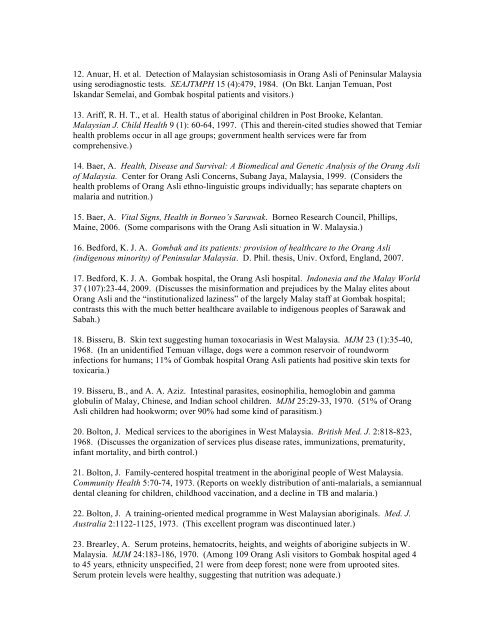Orang Asli (Indigenous Malaysian) Biomedical Bibliography AS Baer
Orang Asli (Indigenous Malaysian) Biomedical Bibliography AS Baer
Orang Asli (Indigenous Malaysian) Biomedical Bibliography AS Baer
You also want an ePaper? Increase the reach of your titles
YUMPU automatically turns print PDFs into web optimized ePapers that Google loves.
12. Anuar, H. et al. Detection of <strong>Malaysian</strong> schistosomiasis in <strong>Orang</strong> <strong>Asli</strong> of Peninsular Malaysia<br />
using serodiagnostic tests. SEAJTMPH 15 (4):479, 1984. (On Bkt. Lanjan Temuan, Post<br />
Iskandar Semelai, and Gombak hospital patients and visitors.)<br />
13. Ariff, R. H. T., et al. Health status of aboriginal children in Post Brooke, Kelantan.<br />
<strong>Malaysian</strong> J. Child Health 9 (1): 60-64, 1997. (This and therein-cited studies showed that Temiar<br />
health problems occur in all age groups; government health services were far from<br />
comprehensive.)<br />
14. <strong>Baer</strong>, A. Health, Disease and Survival: A <strong>Biomedical</strong> and Genetic Analysis of the <strong>Orang</strong> <strong>Asli</strong><br />
of Malaysia. Center for <strong>Orang</strong> <strong>Asli</strong> Concerns, Subang Jaya, Malaysia, 1999. (Considers the<br />
health problems of <strong>Orang</strong> <strong>Asli</strong> ethno-linguistic groups individually; has separate chapters on<br />
malaria and nutrition.)<br />
15. <strong>Baer</strong>, A. Vital Signs, Health in Borneo’s Sarawak. Borneo Research Council, Phillips,<br />
Maine, 2006. (Some comparisons with the <strong>Orang</strong> <strong>Asli</strong> situation in W. Malaysia.)<br />
16. Bedford, K. J. A. Gombak and its patients: provision of healthcare to the <strong>Orang</strong> <strong>Asli</strong><br />
(indigenous minority) of Peninsular Malaysia. D. Phil. thesis, Univ. Oxford, England, 2007.<br />
17. Bedford, K. J. A. Gombak hospital, the <strong>Orang</strong> <strong>Asli</strong> hospital. Indonesia and the Malay World<br />
37 (107):23-44, 2009. (Discusses the misinformation and prejudices by the Malay elites about<br />
<strong>Orang</strong> <strong>Asli</strong> and the “institutionalized laziness” of the largely Malay staff at Gombak hospital;<br />
contrasts this with the much better healthcare available to indigenous peoples of Sarawak and<br />
Sabah.)<br />
18. Bisseru, B. Skin text suggesting human toxocariasis in West Malaysia. MJM 23 (1):35-40,<br />
1968. (In an unidentified Temuan village, dogs were a common reservoir of roundworm<br />
infections for humans; 11% of Gombak hospital <strong>Orang</strong> <strong>Asli</strong> patients had positive skin texts for<br />
toxicaria.)<br />
19. Bisseru, B., and A. A. Aziz. Intestinal parasites, eosinophilia, hemoglobin and gamma<br />
globulin of Malay, Chinese, and Indian school children. MJM 25:29-33, 1970. (51% of <strong>Orang</strong><br />
<strong>Asli</strong> children had hookworm; over 90% had some kind of parasitism.)<br />
20. Bolton, J. Medical services to the aborigines in West Malaysia. British Med. J. 2:818-823,<br />
1968. (Discusses the organization of services plus disease rates, immunizations, prematurity,<br />
infant mortality, and birth control.)<br />
21. Bolton, J. Family-centered hospital treatment in the aboriginal people of West Malaysia.<br />
Community Health 5:70-74, 1973. (Reports on weekly distribution of anti-malarials, a semiannual<br />
dental cleaning for children, childhood vaccination, and a decline in TB and malaria.)<br />
22. Bolton, J. A training-oriented medical programme in West <strong>Malaysian</strong> aboriginals. Med. J.<br />
Australia 2:1122-1125, 1973. (This excellent program was discontinued later.)<br />
23. Brearley, A. Serum proteins, hematocrits, heights, and weights of aborigine subjects in W.<br />
Malaysia. MJM 24:183-186, 1970. (Among 109 <strong>Orang</strong> <strong>Asli</strong> visitors to Gombak hospital aged 4<br />
to 45 years, ethnicity unspecified, 21 were from deep forest; none were from uprooted sites.<br />
Serum protein levels were healthy, suggesting that nutrition was adequate.)















